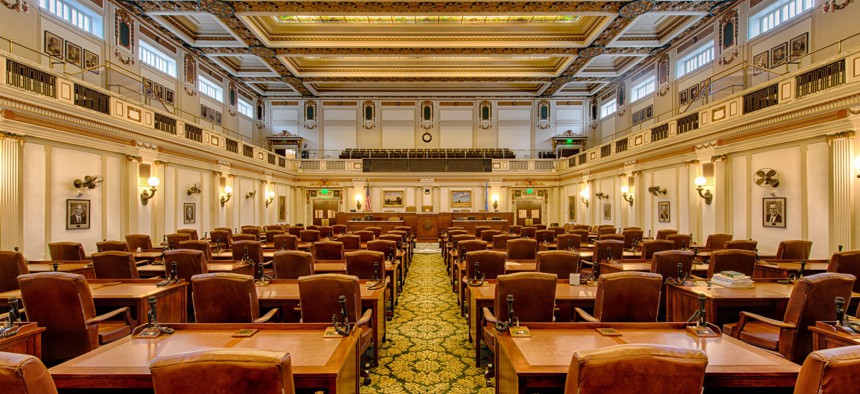State Spending and Revenues Are Finally Reaching Pre-Recession Levels Again

The House chamber in the Oklahoma State Capitol Shutterstock

Connecting state and local government leaders
But arriving at that threshold has taken “an unusually long time.” And progress varies state-to-state.
State spending and revenues are showing signs this year of recovering to pre-recession levels, according to a report issued Tuesday. But progress toward that point has been sluggish and the financial performance of states across the nation remains uneven.
The National Association of State Budget Officers latest Fiscal Survey of States found that, after adjusting for inflation, fiscal year 2016 will be the first time total, estimated state general fund spending and revenue will exceed peaks seen in 2008 when the Great Recession unfolded.
“It's taken six years, since the low point of the recessionary period, for us to recover to that level; an unusually long time for that to take place after a recession,” John Hicks, NASBO’s executive director, said of state spending, as he discussed the survey during a conference call Monday.
Total general fund spending among U.S. states is estimated to be $797 billion in fiscal year 2016, according to NASBO. That’s roughly 1.2 percent above the inflation-adjusted high mark in recent years of about $789 billion in 2008.
General fund revenues in the 2016 fiscal year are expected to be $787 billion, compared to the inflation-adjusted level in 2008 of $780 billion.

General funds typically act as a state’s primary budget account. The NASBO report notes that K-12 education and Medicaid are the two largest areas of state general fund expenditures.
Higher education, corrections, public assistance, and transportation are other major categories.
While overall general fund spending and revenue levels for the 50 states combined have crept upwards, progress has varied state-to-state.
In 29 states fiscal year 2016 general fund expenditures remain below where they stood in 2008, according to the NASBO report. The same is true for general fund revenues in 23 states.
Many states continue to face pressure and complicated budgetary choices stemming from costs related to health care, education, pensions and infrastructure.
And low oil and gas prices have hurt revenues in states such as North Dakota and Oklahoma, where industries tied to those resources loom large. Alaska’s oil revenue woes are further complicated by over two decades of dwindling crude production on the state’s North Slope.
Balances in so-called “rainy day funds,” which act as savings accounts to help states get through recessions or unforeseen events without slashing spending, are estimated at about $49 billion in fiscal year 2016, up from around $45 billion in fiscal year 2015.
During last downturn, and in its aftermath, many states were forced to make difficult spending cuts in order to balance their budgets.
Some experts have suggested another recession could occur in the next three years.
Hicks said Monday that, in terms of building up reserve funds, states are generally “in a pretty similar situation” to where they stood prior to the Great Recession.
“The percent of those reserves as a share of current spending, or current revenues, is still slightly lower than where it was as we walked into 2008,” he added. “But it’s quite close.”
Bill Lucia is a Reporter for Government Executive’s Route Fifty and is based in Washington, D.C.

NEXT STORY: Vermont Passes Legislation Authorizing Dental Therapists





